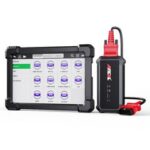Dealing with an illuminated airbag warning light on your BMW can be frustrating. Often, this light signals a minor issue, such as a faulty sensor or a disconnected component, rather than a major airbag system failure. For many BMW owners, especially those with models from the 1990s and early 2000s, the question arises: can an OBD2 scanner be used to reset the airbag light and diagnose the problem? This article delves into the world of Obd2 Scanner Airbag Resets for BMWs, offering insights and guidance.
For owners of older BMW models, particularly those from before 2002, tools like the Peake SRS tool became popular for diagnosing and resetting airbag lights. According to Peake Research, their R5/SRS tool is designed for most BMWs built between 1994 and 2002. It’s important to note their compatibility limitations, as these tools are generally not compatible with BMWs built before 1994, and compatibility decreases sharply after mid-2002, especially for flagship models like the 7 Series. Users have also reported issues with perpetual “01” codes on certain models, such as the 2000 323i.
Alt text: Diagram showing typical locations of OBD2 and 20-pin diagnostic ports in older BMW vehicles, highlighting access points for airbag system scanning and reset.
Another tool frequently mentioned in online forums is the B800 SRS reset tool, often available at a lower price point, including Chinese versions found on auction sites. Testing of these tools on older BMWs has shown mixed results. For instance, a B800 tool might not work on pre-1994 models like a 1993 or 1988 E32 750. However, it has been reported to function on models like a 1998 E36 M3 US spec, successfully reading fault codes (such as a broken passenger seat occupancy mat) and resetting the SRS light after the repair.
Alt text: Image of a B800 BMW SRS Reset Tool, a common aftermarket device used for diagnosing and clearing airbag fault codes in older BMW models.
A crucial point to consider for some BMWs from this era is the diagnostic port location. Certain models feature both a 20-pin round diagnostic port in the engine bay and a standard OBD2 port near the steering wheel. In such cases, for airbag system diagnostics and reset, it’s often necessary to connect the SRS tool to the 20-pin diagnostic port in the engine bay. The OBD2 port in these older models is primarily intended for engine-related diagnostics, as well as oil and inspection resets. This applies not only to specialized tools like the SIR3 and BOA, but also to the B800 tool.
It’s also vital to be aware of potentially misleading advertising, especially concerning the B800 tool. Advertisements might list a wide range of compatible BMW models, such as all E36, E46, E34, E38, E39, Z3, Z4, and X5 variants. While these model ranges are generally covered, it’s often mentioned only later in the description that the tool is actually effective for vehicles manufactured between 1994 and 2003. This can be confusing, as models like the E36 and E34 were also produced before 1994. Always double-check the specific year of your BMW against the tool’s compatibility list to avoid disappointment.
In conclusion, resetting your BMW airbag light with an OBD2 scanner, particularly on older models, requires careful consideration of tool compatibility and diagnostic port location. While dedicated tools like the Peake SRS and B800 have been used, their effectiveness varies depending on the BMW model year. Always ensure you are using a tool that is explicitly compatible with your vehicle’s year and model, and be mindful of the correct diagnostic port to use for SRS system access. For newer BMWs and more comprehensive diagnostics, modern OBD2 scanners with advanced features are increasingly capable of handling airbag system resets, but verifying compatibility remains essential.
